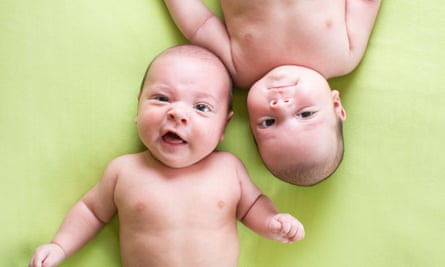In the top 10 of unpleasant sounds, a crying baby ranks very high. It instantly activates a key part of your brain called the amygdala, which, among other things, acts as a sort of radar for emotional threats. So why would babies need to trigger this sort of urgent reaction? To get you to respond – and fast – to ensure their survival.
Babies can’t fend for themselves. They are like chicks in their parents’ nest, depending on others to keep them warm, fed, safe and contented while they develop the brain capacities they need for their particular environment. Like chicks, their cries signal compelling necessities such as a need for food or protection from danger. But human babies can also convey a range of other needs with cries which vary from a quiet grumble to an active whinge to a full-blown distress call, alerting their caregivers to help them get warmer, cooler, or more comfortable, or to stimulate them when bored, soothe them when distressed, and help them get to sleep.
Human babies are also highly social, and are interested in engaging in a dialogue with their caregivers. So they are equally alert to their parents’ signals: to the messages conveyed by the body language of their caregivers – how the parent smells, touches, holds and rocks, as well as their tone of voice. In relaxed moments with the parent, they soon discover how smiling at an attentive adult tends to prompt a positive response in return. Or they might engage in a dialogue of little grunts and facial expressions, each copying the other. These playful encounters help babies become more socially aware – both of themselves and of other people.

On the other hand, these early attempts at communication between parent and child can be very hit and miss. In the first few weeks, most babies cry for about two hours a day. When parent and baby aren’t “getting” each other, crying can escalate. In particular, persistent difficulties with breastfeeding can lead to a pattern of “entrenched” crying behaviour. (And, of course, babies also cry if they are unwell, or have chronic discomfort like a gut inflammation or a urinary tract infection.) In the ordinary run of things, however, parent and baby gradually align themselves and get more skilled at reading each other’s body language. They develop a “musical communication”, as child psychologist Colwyn Trevarthen has called it, through which they can tune in to each other’s emotional states.
It helps if the parent is relaxed and comfortable with their emotions; this will help them to listen sensitively and respond promptly to their baby. It also helps if the baby has had a straightforward experience of gestation and birth, and is not in a state of heightened stress. But this is often not the case. Some less fortunate babies have already been exposed to stress hormones in the womb (if the pregnancy has been particularly stressful, their mother’s own cortisol can cross the placenta and affect the foetus); when they are born, these babies tend to be more irritable and are more prone to crying.

Equally, there are many less fortunate parents. Some feel unsupported because of difficult circumstances such as single parenthood, partner violence or rejection, or because they are still recovering from birth traumas. Many have not been well nurtured themselves as babies, which can shape their capacity to cherish their own babies. Some of these mothers are actually biologically less equipped to enjoy their babies; they respond to them more reluctantly and touch them less, because they have low levels of oxytocin, the “bonding” hormone which makes connection feel good.
Having low oxytocin can also make them more vulnerable to stress and more readily irritated by the baby’s crying, in part because oxytocin plays a significant role in calming the amygdala. These difficulties can make it hard to muster the energy to build a new relationship with their baby.
However, even thriving parents can be driven to distraction by the demands of early parenting. Some turn to solutions such as “controlled crying” to get their baby to sleep through the night, although this is in fact an unusual achievement before the age of six months when babies still have very short sleep cycles and need small but frequent feeds. Such parents may also not realise that when young babies wake at night on their own, they don’t yet have the mental capacity to realise that their beloved caregiver is nearby in the next room; their cries may be a way of expressing their fear of being abandoned, asking “where are you?”, perhaps becoming increasingly despairing.
There is some evidence to suggest that even after such babies have given up crying at night, they remain stressed internally (their stress hormones remain high for at least three days). So parents who practise “controlled crying” in these early months may be sending implicit messages they don’t intend – giving their baby the sense that its feelings don’t matter to anyone or that it can’t turn to other people for comfort and soothing. Instead, she may start to rely on “things” for comfort, such as a dummy or a familiar blanket. This can be the beginning of learning how to cope defensively, trying to be emotionally self-sufficient.
At the opposite end of the spectrum, more indecisive and inconsistent parents, who sometimes overreact to their baby’s distress while at other times ignoring it, are likely to be setting themselves up for a lot of crying. Once the baby realises how unpredictable its parent is, it may discover that it pays to exaggerate its emotions to make sure it gets a response. Alternatively, the crying may convey the child’s frustration with the relationship itself; its crying may be saying “get off me” when the parent is being intrusive, or “where are you?” when the parent is unresponsive.

These babies can grow into demanding children who are always trying to make sure their attachment person is noticing their needs.
Unfortunately, the way things go in these first few months does matter. This is a sensitive period in brain development, when the chronic stress of an out-of-tune relationship can leave lasting effects on the baby’s own amygdala and oxytocin levels, as well as his or her stress response and style of attachment. We know from the worst-case scenario of Romanian orphans that those who were adopted very early (within the first four months) were still able to get their amygdala and stress response back to normal, despite a highly stressful start in life. However, those who were later adoptees continued to have a more reactive amygdala into their teenage years. The same is true for many ordinary children growing up in their own families, when there is a lack of emotional safety; the amygdala can become permanently over-active, creating lifelong tendencies to anxiety or unmanageable aggression.

In more harmonious relationships, parents are setting their children off on a much more benign trajectory. As they get to know each other, parent and child get better at anticipating each other’s behaviours, and the baby has much less need to cry. By three months, most babies cry half as much as they did when newborn. In fact, research shows that the more responsive parents are in the early months, the less their baby will cry later in the year. Through their example, the baby is already becoming more self-aware, and is starting to learn how to calm or distract itself – as well as developing the kinds of self-soothing and reflective brain structures that will eventually give him more control over his own emotions and behaviour.
Crying is a signal that can mean many different things. The way parents and caregivers interpret that signal has huge implications. What kind of world will they convey to the child? A loving community in which the baby can relax, rely on others for support, and come to feel empathy for others? Or an uncertain, threatening environment in which the child must be vigilant and adapt to the needs of the more powerful people around it, learning to rely for comfort on things instead of people?
The lessons that are learned from these early experiences are highly significant for individual lives, but collectively they also have a profound effect on our culture.
More from You asked Google, here’s the answer:
David Shariatmadari: What is depression?
John Bradshaw: Why don’t dogs like cats?
SE Smith: Why don’t I want to have sex?
Joseph Harker: Why are people racist?
